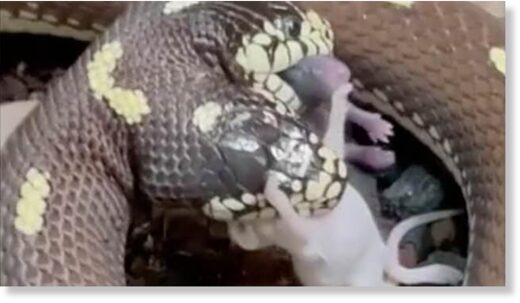When snakes are born with two heads they fight each other for food

When Snakes Are Born With Two Heads, They Fight Each Other for Food

Snakes have always been fascinating creatures, known for their unique physical features and ability to capture prey. While encountering a snake in the wild can be a thrilling experience, stumbling upon a two-headed snake takes this excitement to a whole new level. These rare creatures, also known as bicephalic snakes, have captured the attention of scientists and snake enthusiasts alike due to their unusual appearance and behavior.
Recently, a two-headed snake nicknamed “Double Dave” was discovered in the United States, adding to the small but remarkable list of recorded bicephalic snakes. This find has brought to light the intriguing phenomenon of two-headed snakes and their struggle for survival, particularly when it comes to securing their next meal.

One might assume that having two heads would give a snake a competitive advantage when it comes to hunting and feeding. However, the reality is quite different. In fact, when two-headed snakes are born, they often face significant challenges when it comes to coordination and cooperation. Each head is controlled by a separate brain, and sometimes these brains do not communicate effectively, leading to internal conflict.
When it comes to finding food, this internal rivalry becomes even more pronounced. Two-headed snakes rely on sensing vibrations and smells within their environment to locate potential prey. However, each head may have a different inclination or preference for food, resulting in conflict between the heads. This can lead to intense battles as they fight over the captured prey or try to overpower each other to secure their next meal.
In some cases, this competition can be detrimental to the snake’s survival. If the heads fail to work together and coordinate their actions, the snake may struggle to capture prey efficiently or even starve. This is particularly true when the prey is large and requires both heads to work in unison.
Despite the challenges they face, two-headed snakes continue to captivate researchers who are eager to understand their unique biology and behavior. This fascination extends to snake enthusiasts and curious individuals who are intrigued by the remarkable abilities and adaptations of these extraordinary creatures.
In conclusion, the phenomenon of two-headed snakes battling each other for food is a captivating and complex aspect of their behavior. Understanding the struggles they face in coordination and cooperation adds another layer of admiration for these fascinating creatures. As researchers continue to shed light on the intricacies of two-headed snakes, it provides us with a glimpse into the remarkable diversity of life on our planet.
Source: The Guardian
Related Posts
Quick Links
Legal Stuff

